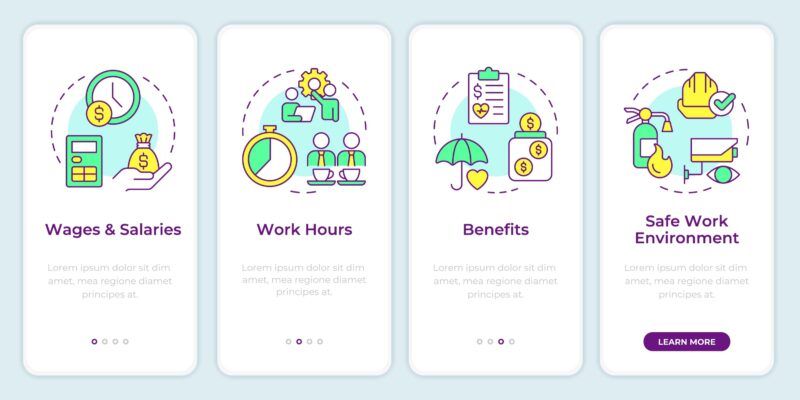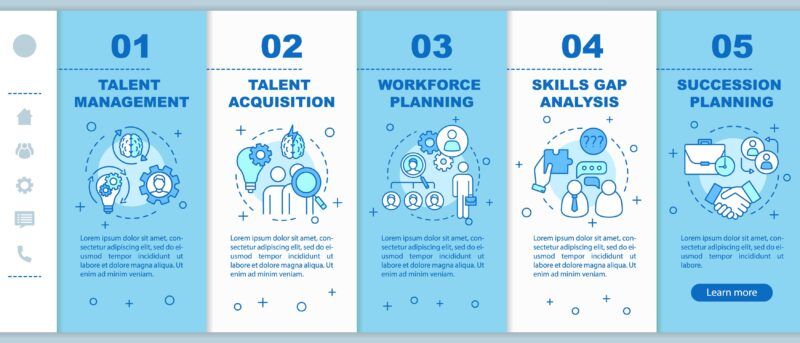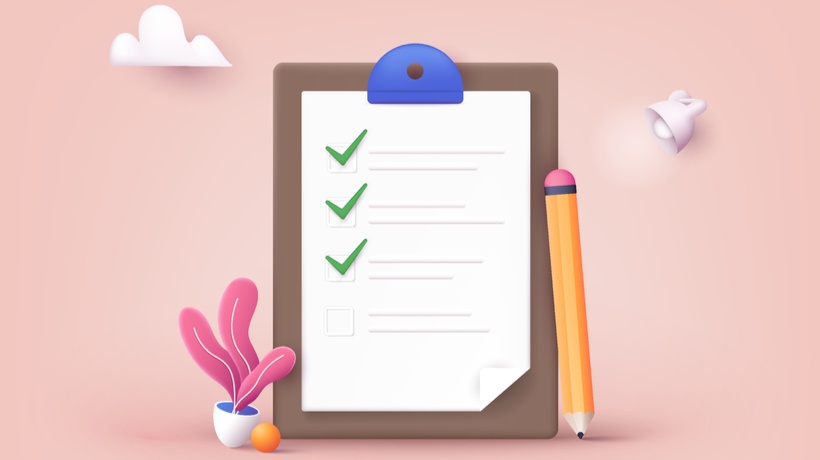What Is A New Employee Onboarding Checklist?
Onboarding is a crucial phase that organizations must excel in. According to a Glassdoor study, a solid onboarding process improves new hire retention by 82% and enhances recruit productivity by 72%. Therefore, following a new employee onboarding checklist should be mandatory in companies to help new hires settle into their roles.
An onboarding checklist outlines tasks, processes, and vital resources that employees need to know about in their first few days or weeks of employment. From filling out forms to meeting new teammates, the checklist helps employees navigate the new organizational landscape. It's like a roadmap to ensure that nothing gets missed and that they can start on the right foot.
What You'll Find In This Guide:
- Why Is An Onboarding Checklist Important For New Hires?
- How To Create A Checklist For Onboarding New Employees
- What Are The Benefits Of Using Onboarding Checklist Templates?
- What To Include In A Checklist For Onboarding
- 12 Onboarding Template Checklists To Cover Every Need

Why Is An Onboarding Checklist Important For New Hires?
Why should you even care about an onboarding checklist? Employees who have a positive experience in their initial 90 days are ten times more likely to stay with an organization. A great checklist makes sure your new hire feels supported, confident, and ready to take on their new role. Let's dive into why this checklist is a total game-changer.
Improved Performance
A solid checklist helps new employees get up to speed faster. On average, new hires have 54 onboarding tasks to complete, according to Sapling. The sheer number of tasks can add to the negative experience for your recruits if they are not organized and easy to follow. However, with a good checklist, you can outline what needs to get done and when. Without it, they might be left wondering what their priorities are, which can slow them down. With a checklist, they can start performing at their best sooner rather than later. That means fewer questions and more time spent getting things done.
Boost Retention
Nobody likes feeling lost on their first day. A messy or confusing onboarding experience can lead to frustration and even early turnover. But with a good checklist, your new hire knows what's coming up and what's expected of them. That's a huge confidence booster! When they feel supported and clear about their role, they're much more likely to stick around for the long haul. After all, no one wants them to quit their new job after a bad first week.
Consistency And Efficiency
Onboarding can get chaotic, especially in bigger teams. A checklist makes sure that, no matter who's starting, they're getting the same experience. No more "Did we forget to tell them that?" moments; everything's covered. It saves time for managers, too, because they don't have to explain everything over and over again. Instead, they can just point to the checklist and make sure their new hire is staying on track.
How To Create A Checklist For Onboarding New Employees
After a long process of identifying, screening, and interviewing possible candidates, you are finally ready to welcome one or more new team members to the office. The first impression you give them is vital. 41% of employers feel that a lack of structured onboarding harms their company, and if you are among them, the absence of planning can discourage and upset new hires. It can severely affect their professional journey with your company. A positive onboarding experience helps new hires overcome their initial nervousness and quickly become productive.
On the contrary, failing at onboarding will probably lead you to another recruitment process sooner rather than later. To ensure a smooth and successful experience on the first go, organize the steps you need to take with a checklist for onboarding.
What Are The Benefits Of Using Onboarding Checklist Templates?
Onboarding checklist templates help businesses streamline and improve their employee onboarding process. Providing a structured approach ensures that all necessary steps are followed, making the transition into a new role smooth and efficient. These templates guide HR departments, managers, and employees, providing clarity and reducing the chances of forgetting important tasks.
Additionally, onboarding checklists are valuable tools for creating consistent processes across the company and offering a standardized experience for all new hires. They also help you save money because training every new person you hire requires resources. The cost of training an employee is $1,678 on average, but if you can retain them, you'll reap the rewards of your investment in the long run.
What's more, organizations that use onboarding templates improve employee engagement, reduce turnover rates, and foster a positive company culture. Let's explore the benefits of using these onboarding checklist templates in more detail.
Efficiency
When you're juggling a million tasks, trying to remember what's next on your to-do list can be chaotic. However, an onboarding checklist template can help you note important tasks and streamline the process of welcoming new people into your team. With a checklist, every step is laid out so you don't have to worry about forgetting something. When you streamline the onboarding process, you save time both for you and your new employees, as they will not be left guessing what they need to do next. Instead of spending hours figuring out what paperwork to fill out or where to find resources, they can dive right into their new role.
Clear Expectations
New hires often feel confused on their first day, wondering what they should be doing. Enter the onboarding checklist, which clears up what's expected of them every step of the way. Moreover, when new employees know what they're supposed to do, it fosters accountability. They can get productive from day one instead of trying to figure out instructions. Plus, it brings a sense of ownership. When they know their goals and responsibilities, they're more likely to take initiative. And let's not forget about feedback. Clear expectations are the foundation of discussions about performance. This is because when these expectations are not met, it's easier to talk about what went wrong.
Improved Employee Retention
A structured onboarding process helps recruits with the stress of a new role. When new employees have a clear path laid out before them, they feel more supported and comfortable during the onboarding process. Proper onboarding is perfect for engagement. If the newcomers feel valued from the start, they are more connected to the company culture; thus, they are more likely to stick around and try their best. Not to mention that a well-planned onboarding process makes a great first impression. If new hires enter an organization that showcases their values from the get-go, they know they made the right choice.
Time Management
Having an onboarding checklist helps you keep everything in line, making sure new employees don't get lost while filling out paperwork and following procedures. With a clear timeline of tasks, both managers and new hires can track progress, ensuring they don't miss anything crucial. Most importantly, it saves time. With a solid onboarding plan, everyone does their tasks as they are supposed to, quickening the process and helping new hires become active in their new role as soon as possible. This means more time for them to dive into their new responsibilities and more time for you to focus on other tasks and projects.

What To Include In A Checklist For Onboarding
An employee onboarding checklist can take multiple forms depending on your addition's role and your organizational needs. Still, the following steps should always be part of the onboarding process.
Recruitment Process
Focusing on the recruitment process, let's see what needs to be incorporated into the checklist to ensure a seamless transition. Firstly, make sure that all required documents are ready and sent to the new employee. This includes offer letters, employment agreements, and any other necessary paperwork. It's essential to clearly outline their job position, duties, and expectations in these documents. Then, all meetings, such as an initial meeting with HR, will be arranged for the new employee to finalize their onboarding paperwork.
Welcome Kit
Making a welcome package for new employees is a great way to show them they're valued right from the beginning. But what exactly should be included in this important kit? To start, you can include some company merchandise, like shirts, coffee mugs, notebooks, and pens. Next, consider adding a welcome letter. A personal message from a supervisor or even the CEO makes new hires feel special. This letter can express the company's excitement about their new addition and offer some words of encouragement as they embark on their journey.
Setting Up The Workspace
When you're onboarding a new team member, it's crucial to set up their workspace properly so they can feel welcomed and get started smoothly. First off, ensure that their desk and chairs are ergonomic for comfort and productivity. Next, make sure they have all the necessary equipment, like a computer and peripherals, ready to go. Don't forget to install all the essential software they'll need for their role. Most importantly, they should have their login credentials prepared for all systems and networks to avoid any delays on their first day.
Team Introductions
Now, you should prioritize team introductions. This is key in making them feel like part of the team right away. First, set up a meet-and-greet, whether it's a casual coffee break or a more structured meeting where everyone gives a quick intro about themselves. Then, make sure they know who to go to for different needs. Introduce them to their manager, mentor, buddy, and key contacts in other departments. If remote, consider a team lunch or virtual happy hour to create a relaxed environment for getting to know colleagues on a personal level. Lastly, provide a team directory with photos, names, roles, and contact info to make it easier for the new hire to reach out as needed.
Breaking Down New Role's Responsibilities
It's also important to outline their responsibilities in detail. This not only lets them know what's expected but also helps them feel supported right from the start. Begin by giving them a thorough job description. Even though they may have seen it before, breaking it down further will make their day-to-day tasks more straightforward. Point out the primary responsibilities and how they fit into the team's objectives. Then, lay out the specific projects they'll be starting with. Knowing what they'll be working on will give them a practical idea of their role. Be sure to include timelines and any important milestones, too, to help them stay on track.
Setting Goals
Clearly define the short-term and long-term goals for the new team member. Short-term goals could involve understanding company policies, finishing initial training sessions, or getting to know colleagues. These targets assist the new employee in feeling a sense of immediate achievement and inclusion.
Move on to discussing long-term goals, like mastering particular skills, leading a project, or achieving performance goals in the initial six months. It's also helpful to ensure these goals are SMART (Specific, Measurable, Achievable, Relevant, and Time-bound). For example, instead of stating "enhance communication skills," specify "complete communication training and lead a conversation in a meeting within the first month."
Role-Related Employee Training
Role-related employee training helps new hires get up to speed quickly and feel confident in their new positions. You need to tailor training to the specific tasks the new employee will be handling. This could involve hands-on practice with the software they'll be using, shadowing experienced colleagues, or attending workshops. Finally, your new hires also need training about tools and resources. Provide them access to necessary software, introduce them to project management platforms, and guide them on how to navigate internal databases or systems.
Introduction To Company Culture
Familiarize new employees with the company's mission and vision before diving into the company culture. These serve as the foundation for all operations and choices made within the company. Once they understand these principles, they can better align their efforts and mindset with the company's overall goals.
Additionally, provide details about the day-to-day culture, such as the dress code, work hours, and remote work policies. Discuss communication preferences, whether formal or informal, and stress the significance of teamwork and collaboration. Don't forget to touch on social aspects as well, like company events and team-building activities.
Frequent Check-Ins
Start by arranging a meeting with the new team member on their first day. This initial check-in sets the stage and allows for any immediate questions or concerns to be addressed. Follow up with daily check-ins throughout the first week, which can be quick, informal conversations to ensure they feel supported and understand their responsibilities. Once the first week is over, switch to weekly check-ins. These can be more formal, focusing on progress, obstacles, and any additional training required. Lastly, monthly check-ins should continue for at least the first three to six months. These sessions can delve deeper into long-term objectives, performance evaluations, and career growth plans.
Tracking Progress
Create a method for tracking progress. This could be an essential checklist, a shared file, or a more advanced software solution. The important thing is to monitor what has been accomplished and what is still pending. It's also essential to encourage new employees to give feedback on their onboarding experience. This can identify areas for improvement and help streamline the process for future hires.
Additionally, the new hire's skills and knowledge must be regularly evaluated to ensure they meet the required standards. This could involve informal quizzes, practical assignments, or peer evaluations. By monitoring progress, you can create a more organized and supportive onboarding process, setting your new hires up for success from day one.
12 Onboarding Template Checklists To Cover Every Need
Now, let's dig a little deeper into the various new hire checklists you can use. These differ according to new employees' position, work conditions, or stage of onboarding.
1. Preboarding Checklist
This employee onboarding checklist template is usually ignored among businesses. It covers the period between the day of the job offer and your new hire's first day at the office. However, research shows that companies that make an effort to establish a relationship with their employees before their actual start date have higher rates of employee retention.
Preboarding usually starts with a welcome email. The message that you send to your new employee must be welcoming and inviting to get them excited for their first day. Make sure to include any important information, such as the specific start date, clock-in time, office address, or any paperwork they need to present.
Moreover, you could give them access to a brief overview of company policies. These can be code of conduct or office environment handbooks, so that they know what to expect. Finally, don't forget to do some internal preparation by informing your current team about the new arrival. Share a few interesting facts that will act as icebreakers during the first days and encourage them to make their newly hired colleague feel comfortable.

2. First Day Checklist
The first day is finally here, and the official onboarding process can begin. An office tour is definitely where you should start. It helps them familiarize themselves with the various office spaces and meet their new colleagues. If you're working remotely, a virtual tour of the different departments will introduce your hire to colleagues, executives, and their immediate team.
Another crucial step to make an employee feel welcome is to have their workstation ready prior to their arrival. Provide all the necessary supplies and help them set up their equipment. Show them the tools they will use daily and set up training sessions for the following days so that they can get the hang of them as soon as possible.
Although it takes up a large part of it, the first day is not all about socializing. Employees also need to fill out the remaining paperwork and get introduced to their responsibilities. Take some time to discuss your expectations, their individual and team goals, and a training plan for the near future. Finally, introduce them to the CEO or executive they will be reporting to so that they can share a few welcoming and encouraging words.
3. First Week Checklist
During the first week of their employment, new hires are settling into their responsibilities and learning more about the company culture and way of functioning. This is why the goals and tasks you set during that initial week must be designed to reinforce the values that you want them to learn.
For example, you can organize social activities or collaborative work to encourage them to explore the significance of teamwork or the preferred ways of communication in your company. In general, however, the first week is dedicated to training on role-based skills, custom tools, compliance, office etiquette, and more. Develop a training plan, provide access to useful resources, and remember to check in daily so that you can collect feedback to optimize the onboarding experience.
4. First Month(s) Checklist
As soon as the employee has gained enough confidence in tools, tasks, and procedures, it's time to consider a more goal-driven plan. A great onboarding template to follow is the 30-60-90 plan, which achieves high levels of productivity within the first ninety days of employment by developing specific SMART goals for each period.
Specifically, the first 30 days are focused on basic details, such as those described in the first-week checklist template for onboarding. Days 30–60 involve the new employee even more in the company's overarching goals. At that point, employees take on tasks relevant to organizational objectives and have regular meetings with colleagues and supervisors.
By day 90, the employee is confident and knowledgeable enough to work independently, take responsibility for their work, and achieve goals. Collect feedback during each stage to track progress and ensure that no adjustments need to be made.

5. Onboarding Template Checklist For Managers
Despite juggling many other tasks, managers must be involved in the process of onboarding new employees. In fact, they must coordinate it and guarantee its success. Therefore, to ensure they don't skip any steps, it would be wise to follow a checklist template of their own. Some items that could be included in it would be identifying which tools they need to train the new employee on, setting short- and long-term goals for them, and clarifying what results they are expecting at each milestone.
Preparing the workplace for the arrival of the employee by announcing it to the rest of the company must also be part of the manager's checklist. The announcement must be on multiple channels and include essential information about the new hire's role and how they will contribute to the company's mission.
6. Onboarding Training Template Checklist For Sales Teams
The first stages of onboarding are common for all employees, as the main goal is to become acclimated to the work environment and culture. However, after the one-week mark, you need to start customizing your onboarding checklists depending on your employee's role.
Therefore, once your latest addition to the sales team has gained confidence, it's time to start training them on product knowledge, lead attraction and conversion, negotiation skills, etc. You can modify your onboarding template according to your employees' needs and gaps and your company's requirements.

7. Template Checklist For Remote Employees
Remote employee onboarding can be challenging, as employees need to have a welcoming experience through a computer screen. Nevertheless, the items on your onboarding checklist remain the same. Only the manner of delivery changes.
For example, instead of walking around the office to meet their colleagues, they enter a few video conferences. In any case, the most important thing to remember when onboarding a remote employee is providing continuous support. Give them the necessary equipment, access to resources (such as communication guidelines and the employee handbook), and the names of people who can help them with different things. Moreover, schedule regular meetings so that your new hire doesn't feel alone.
8. Template Checklist To Foster Cultures Of Learning
Introducing a newcomer to your company culture is of utmost importance for quick assimilation and high productivity levels. Therefore, your onboarding checklist should include a culture-related section that starts with preboarding. At that point, you can demonstrate your values during interviews and in the welcome email. The first week is when the real introduction happens.
New employees meet their colleagues, participate in collaborative activities, and, of course, read your company handbook, which includes your mission, vision, goals, and core values. Make sure to discuss all of that with them so that you can explain the reasoning behind your culture and how you got here. However, remember that culture can't be taught. You can provide the resources and create opportunities for your employees to see it firsthand; hopefully, they will adopt it.
9. IT Onboarding Checklist
Before you have your new IT member prove their tech skills, you should ease them into their first week. How are you going to do that? With an IT onboarding checklist. This includes all the vital resources your recruit will need, as well as the initial tasks like filling out forms. A good checklist will also outline all the essential tools and programs they must get familiar with. Just because they're IT recruits, it doesn't mean they're experts at all things tech.
So, instead of wasting their time asking questions or Googling problems, they should have a full list of resources regarding the software they use in their new roles. Finally, don't forget about the security protocols; your checklist must cover all the policies regarding cybersecurity.

10. New Employee Training Checklists
New employee training checklists usually cover each recruit's job-specific training. This is where new hires learn the ins and outs of their role, from software tutorials to compliance training. The checklist lays out every single course they will be attending and its timeline so that you are certain that they don't spend too much time on each topic.
This checklist helps you keep track of everyone's training, which is especially useful when you're onboarding multiple employees for different roles. So, you will no longer wonder if you forgot to assign lessons or accidentally enrolled someone into training for an entirely different subject matter.
11. HR Onboarding Checklist
When it comes to onboarding new employees in the HR department, having a checklist can make all the difference. First off, you'll want to ensure they complete all necessary paperwork. Keep in mind that they must also understand all the procedures regarding tax and payroll, as they will have to deal with these matters, too. Introduce them to company policies and procedures.
Training in HR systems and software is also essential. They must have access to relevant tools like your HR management system and any applicant tracking systems. A quick tutorial on these platforms will help them be productive as soon as possible. Lastly, they should be introduced to team members in different departments with whom they'll collaborate often. This will make communication and teamwork much more manageable.

12. Developer Onboarding Checklist Template
A developer onboarding checklist template typically starts with administrative tasks like setting up company accounts, email, project management tools, and other systems. This way, developers can begin showcasing their skills right from the start. Next, there's often a section dedicated to development environment setup. This includes instructions on installing necessary software, configuring local development environments, and accessing repositories.
Another part is guiding new developers through a code walkthrough, highlighting key areas of the code, and explaining the architecture. Providing access to relevant documentation, such as API references or coding standards, will also come in handy. Finally, don't forget about training resources. Providing access to coding tutorials, online courses, or internal training materials can help them grow their skills and be prepared to succeed in their new role immediately.
Conclusion
Onboarding makes the difference between a successful and a failed hire. By making it part of your culture, you ensure that your new hires feel comfortable and that they become valuable and productive members of the team faster. In addition, a successful onboarding process makes employees stay longer at a company and achieve their maximum potential. Follow the checklist templates for onboarding that we shared in this article, and change the way you welcome your employees.
Compare the top content providers for employee onboarding to find the right outsourcing partner for your program. Our list features the best corporate training for your newest team members.
Image credits:
- Gumbariya/Shutterstock.com
- bsd studio/Shutterstock.com
- PeopleImages.com - Yuri A/Shutterstock.com
- TippaPatt/Shutterstock.com
- Bojan Milinkov/Shutterstock.com










